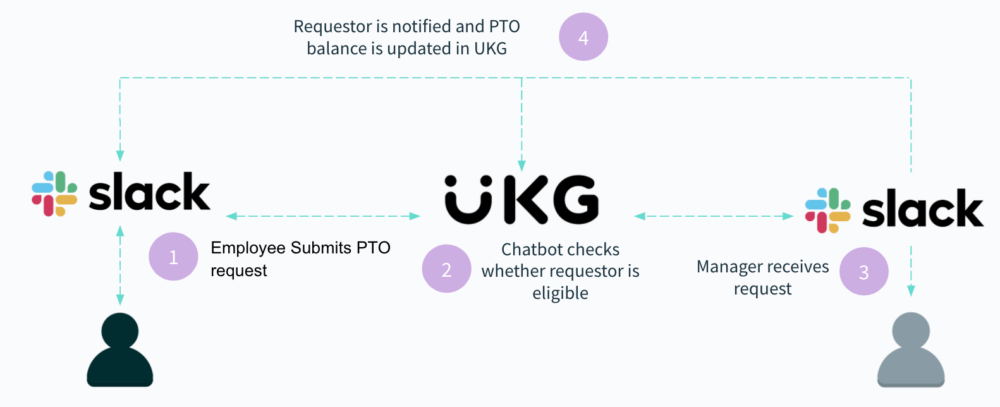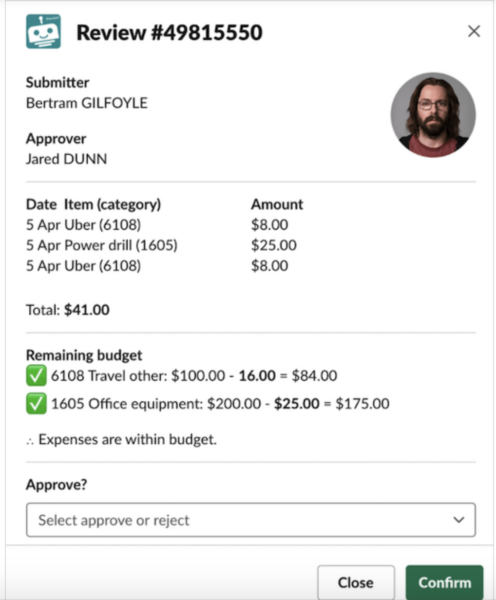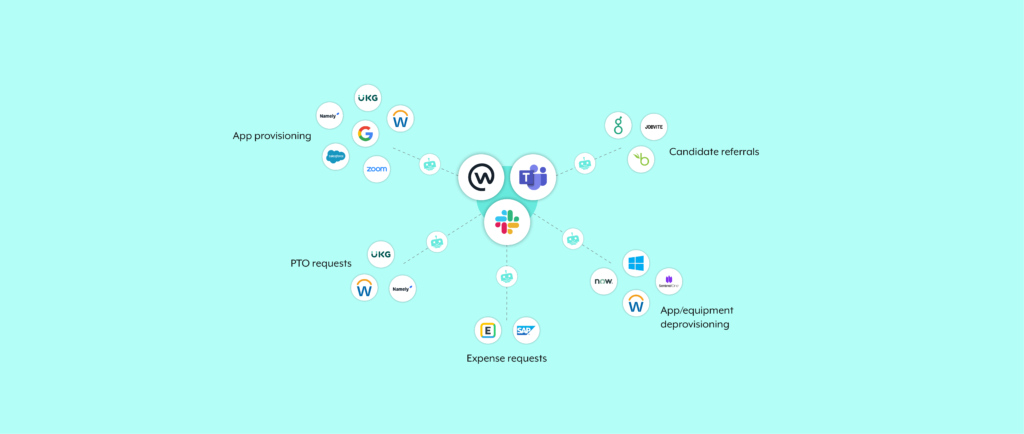When we surveyed 100 IT executives as part of our State of Automation study, we found that many organizations already automate several employee and candidate-focused workflows.
More than half (56%) of respondents, for example, said that their organization is automating their PTO request and approval process, while just shy of half (43%) are automating their application provisioning process.
Why are HR automations so pervasive? And how are organizations automating the employee workflows mentioned above—among others?
We’ll tackle both questions. That way, you’ll know why HR automations are so important as well as how you can implement them successfully. But to start, let’s align on the meaning of HR automation.
Transform any HR process with Workato
Schedule a demoHR automation definition
It’s the use of automation to transform an HR process. This requires a platform that can listen for predefined business events (or triggers); depending on the event that takes place, the platform would go on to perform specific actions across your applications, data, and employees.
As you’ll see in our examples below, HR automations frequently leverage chatbots that bring automations directly to where employees already work—your business communications platform.
HR automation examples
Let’s explore several use cases that cover different HR processes, from recruiting to onboarding to off-boarding.
1. Scale employee referrals by simplifying the submission process
Numerous studies point to the benefits of referring candidates. For example, referral candidates are easier to recruit, and once they’re hired, they’re more likely to stay at your company for longer.
The question then, isn’t if you should hire employees via referrals—it’s how you can increase the number of referrals for an open position.
Here’s an automation that can help, as it allows employees to submit referrals within the comfort of their business communications platform (e.g. Slack).
1. An employee accesses a chatbot within their business comms platform and types in a command, like “add new referral.”
2. The employee then sees a popup where they can add information about the candidate, such as their first name, last name, the position they’re being referred for, the link to their Linkedin profile, etc.
3. Once submitted, the chatbot creates the candidate profile in your applicant tracking system (ATS), and, in the profile, it adds the information provided by the referrer.
4. The recruiter then gets notified of the referral in the business comms platform, where they can forward the candidate to the hiring manager with the click of a button.
It’s worth noting that the chatbot also keeps the employee who submitted the referral in the loop, as they’d get notified when the candidate has either been hired or rejected.
Popular Greenhouse integrations
2. Improve employee onboarding by providing new hires with the apps they need on their first day
Providing each new employee with the applications they need on their first day is a surefire way to help them hit the ground running.
Here’s an onboarding automation our human resources team uses to do just that:
1. Once a new hire notice—an email that alerts stakeholders of key details on the new hire—gets sent by your HRIS, the workflow gets triggered.
2. The hiring manager receives a message from a chatbot that asks them to select the apps that their incoming team member needs (which they can do within the chat).
3. Once the hiring manager makes their selections, the chatbot notifies the BT team via chat. A member of the BT team can then confirm whether they have enough licenses to accommodate the provisions or if they need to acquire more. A team member would then go on to schedule the appropriate provisions for the beginning of the new hire’s first day.
4. Once the new hire comes onboard, they can request access to additional apps or to different access levels for any via another chatbot (which we refer to as “Firefighter Bot”).
3. Streamline PTO approvals by enabling employees to easily submit and review PTO requests
Every employee, regardless of department, location, or tenure, will request paid time off at your company.
You can make each of their experiences—as well as the approvers’—easy by implementing the following:

1. An employee submits their PTO request via a chatbot in your business comms platform (which requires them to select the specific days they’re taking off).
2. The chatbot quickly checks if they’re eligible to take those days off in your HRIS (e.g. UKG Pro).
3. Assuming the requestor is eligible, the chatbot notifies their manager via a chat message.
4. The manager can approve (or reject) the request with the click of a button. If approved, the chatbot would update the requestor’s PTO balance and notify them of the decision (via a chat message).
Related: How automation can transform approval process workflows
4. Automate expense reports by empowering employees to submit and approve (or reject) them in a matter of clicks
Similar to the previous example, most—if not all—employees will find themselves submitting expenses.
You can use automation to make it easier on employees to submit expenses as well as approve any by implementing the following expense approval process:
1. An employee accesses a chatbot within the business comms platform and types a command like “submit expense.”
2. A pop-up appears that asks the employee for the information required to submit the expense. This includes items like the employee’s full name, the type of expense they’re submitting, and the amount they’re expensing.
3. The employee uploads a photo of their receipt(s) and they can then submit the expense—which prompts the chatbot to created the expense in your expense management system.
4. The employee’s manager then receives a message from the chatbot, notifying them of the request, and allowing them to review and approve (or reject) it with the click of a button.

5. Once approved (or rejected), the chatbot would send the requestor a message that notifies them of their manager’s decision, and it updates the status of the expense in the system.
Related: What is an HR chatbot? And what are some common examples?
5. Offboard employees securely by turning off their access to devices
As soon as an employee leaves your company, you’ll want to prevent them from engaging in behavior that can harm your employees, clients, and the reputation of your organization.
Here’s an offboarding automation that can make a big impact, as it effectively shuts off access to their laptop once they’re no longer an employee.

- Once an employee is marked as terminated in your HRIS, the workflow gets triggered.
- Your ITSM tool creates tickets for a range of tasks related to offboarding the employee.
- By the end of the employee’s last day, they’re removed from groups in Active Directory and they lose access to their laptop.
HR automation benefits
Now that you know various ways to implement HR automation, you likely understand the benefits it can bring to your human resources department and the rest of your employees.
But in case any skip your attention, let’s break down several.
- Employees can avoid tedious, time-consuming tasks. Automation helps your employees avoid manual activities, such as app hopping or data entry. Employees can then allocate those time savings toward meaningful, strategic work they’re more likely to value and enjoy.
- New employees can be onboarded more effectively. By using an onboarding process that’s largely automated, new hires are more likely to be set up for success. This, in turn, benefits your organization, as a high-performing employee onboarding process is proven to increase employee retention and productivity.
- Employees are provided with experiences that delight them. Their ability to make requests, submit referrals, get access to apps or equipment, etc. with ease not only helps them be productive, but also more content with your organization. Moreover, since these automations can be applied throughout the organization, they can prove to be effective at preventing (or at least mitigating) an issue that organizations are currently wary of: mass turnover.
- Your time-to-hire shortens. By streamlining the employee referral process, in addition to other recruitment workflows, like resume screening, you can identify more qualified candidates faster and focus more of your time on recruiting them.
- Security issues are less likely to occur. Removing former employees from your apps and taking away their access to equipment lessens their chances of using data in ways that compromise your employees, clients, and your organization more broadly.
In addition, automating processes for current employees—like app provisioning—can help ensure that the appropriate security precautions get taken.
- Overall business performance can improve. More than 3 out of 4 respondents in a survey from Forrester cited higher revenue as a result of their employee experience initiatives. Half of the respondents even said that these initiatives have enabled them to meet their growth goals. These stats go to show that while HR automation might benefit employees first, every party eventually profits.
HR automation challenges
Unfortunately, HR automation can also present issues.
Here are just a few to keep in mind.
1. Doubling down on a flawed process
Automating a faulty process won’t fix the process itself; on the contrary, it’s likely to exacerbate the issues it’s causing.
2. Depending on a few personnel
Many tools that let you implement HR automations require a certain level of technical expertise to use. Since few, if any, of your employees likely have this expertise, your organization’s ability to build and maintain HR automations at scale will naturally be compromised.
3. Automating tasks while ignoring processes
Many tools in the market are also geared towards automating HR-related activities that your employees already perform. And while this offers some benefits, such as time savings and a reduction in human errors, it doesn’t let you reimagine and transform key parts of the employee experience (e.g. onboarding).
4. Over relying on specific HR apps
Having your team implement integrations and automations inside of HR applications, like your HRIS, presents a few issues. For one, these implementations require a very specific skillset that’s difficult to find and retain. Moreover, if and when your organization needs to move away from that application, all of the integrations and automations you’ve built inside of it will also go away.
5. Building brittle automations at the UI-level
Your applications’ UIs will inevitably change over time. When they do, any of the UI-based integrations and automations you’ve built can easily break—forcing your team to respond quickly.
HR automation best practices
Here are some tips and tricks that can help your team build powerful automations:
1. Determine your business goals
This can be anything from acheiving a higher satsifaction rating from employee surveys to onboarding employees a certain number of days faster. With these goals in mind, you’ll be better positioned to prioritize your automations and build each more thoughtfully.
2. Closely monitor each HR automation after pushing it to production
While your builders likely test each automation extensively, all kinds of issues can slip through the cracks. To help you team detect and address such issues quickly, your team can monitor each automation for the first few weeks after it’s gone live.
3. Revisit your HR automations on a recurring cadence
Your HR automations likely have room for improvement, whether that’s adding additional steps, improving the business logic at a certain step, replacing the applications that get used, etc. To pinpoint these areas of improvement, you should look over each automation on a cadence that’s feasible for your team—such as every 6 months.
HR automation tools
Once you’re bought into automating your HR processes, you’ll need to decide on an automation solution that makes the most sense for your business. To help make your decision easier, let’s review the options you’ll likely need to consider:
1. Native integration
This involves using the integration capabilities provided by your HR tools themselves—whether that’s your HRIS, ATS, learning management system (LMS), employee survey platform, etc.
Native integrations typically come at a low price point (they may even be included in your subscription); they also often come with a high level of support, as the vendor sees them as a way to retain (and perhaps extend) customer relationships.
That said, their functionality is generally limited, as the vendor can’t assign many engineering resources toward maintaining and enhancing them. Moreover, they may only offer integrations to select vendors, making them potentially irrelevant or insufficient, based on your organizations’ needs.
2. Robotic process automation (RPA) software
RPA provides “bots”, or software scripts, that can copy human activities at the UI level (e.g. copying and pasting information between applications).
By using RPA software to perform these tasks, employees are freed up to focus on more interesting and important activities. In addition, they’re able to avoid mistakes that typically come with performing data entry-type work (i.e. human errors).
However, RPA software’s bots can easily break. A small change in an application’s UI, for example, can be all it takes to stop a bot from working. Given its vulnerability, RPA software typically requires oversight and maintenance; if used at scale, you might even need several full-time employees to manage the platform.
3. Integration platform as a service (iPaaS)
An iPaaS allows you to connect your SaaS applications and on-prem systems (that use APIs) and build data flows between them. In addition, it allows you to easily establish and maintain governance and security controls—all but ensuring that your data stays protected over time.
Like the previous options, there are also drawbacks to consider. Namely, it doesn’t offer powerful automation capabilities; the platform is built to move data or keep it in sync across your apps.
4. Enterprise automation platform
This type of platform neatly addresses the drawbacks from the options above.
It allows you to integrate your applications AND automate your workflows through a low-code/no-code UX. This empowers a broader set of employees to get involved, which helps your team not only automate at scale but also utilize employees’ business expertise when designing the automations.
The platform also offers: a built-in bot framework to help bring automations to your business comms platform, hundreds of thousands of automation templates and more than a thousand pre-built connectors to help your teams ideate and implement automations quickly, and enterprise-grade security and governance.

Ready to streamline your HR workflows?
Learn how Workato, the leading enterprise automation platform, can help by scheduling a demo with one of our automation experts.
